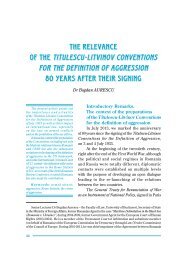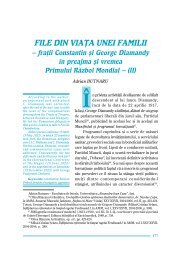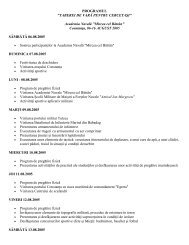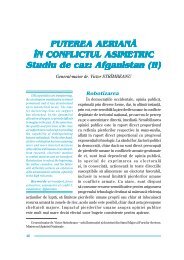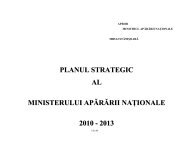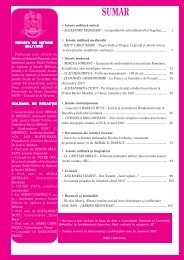Create successful ePaper yourself
Turn your PDF publications into a flip-book with our unique Google optimized e-Paper software.
In 582 the Avarians, a barbaric race coming<br />
from Mongolia and Manchouria that had settled<br />
in the plains of Pannonia three years earlier, occupied<br />
Sirmion that was lying in the European border<br />
of the Byzantine Empire since 437. 16 Since that<br />
time, the Avarians along with their Slav allies literally<br />
ravaged the Byzantine territory lying between<br />
the junction of the rivers Istros and Savus and up<br />
to the west coast of the Euxine. Those barbaric<br />
races carried out several operations in the west<br />
coast. From the winter of 599 until April 600 laid<br />
siege to the city of Tomis (the ancient colony of<br />
Tomi) thus posing a threat even to Constantinople.<br />
At the end, a peace treaty was signed thus reconstituting<br />
the north borders of Byzantium. 17<br />
A little later and in the first years of Heraclius’<br />
Reign (610-641), a mass settlement by Slavic races<br />
took place in various regions of the Balkan peninsula<br />
and the prosperous old colony of Istria, in the<br />
West coast of the Euxine. 18 The Slavs, due to the<br />
primitive civil and military structure and the division<br />
in small groups did not constitute a serious threat<br />
to the Byzantine Empire. Things deteriorated when<br />
the Bulgarians, a barbarian Asian race that came<br />
from the mixing of Huns and Ogours and they were<br />
inhabiting the North of the Euxine, started to press<br />
on the Slavs as they settled hither to the Danube. 19<br />
The many disturbances and the frequent raids<br />
of Bulgarians in Byzantine territory constituted a<br />
severe threat to Byzantium. The Emperor<br />
Constantine V (741-775) confronted the Bulgarian<br />
threat in repeated campaigns, with foremost the<br />
battle in the plain of Anchialos, a prosperous<br />
Greek city on the West coast of the Euxine (June<br />
30, 763). In that battle, the Bulgarians were defeated<br />
and their remnants were forced to disorderly<br />
retreat. 20<br />
The cities of Anchialos, Debeltos and several<br />
other cities in Thrace, near the Euxine coast suffered<br />
new raids by the Bulgarians in the spring of<br />
812, a year after Emperor Nicephorous I (802-811)<br />
was heavily defeated by the numerous forces of<br />
Kroumos. Following that victory, Kroumos spread<br />
the fear and terror in the inhabitants of those cities,<br />
killing several of them and forcing others in exile. 21<br />
During the VIII th and the IX th centuries, the<br />
Empire’s administrative institutions were re-<br />
formed and the Theme system was developed in<br />
an attempt to further reinforce the self-government<br />
of the provinces. The Themes were military<br />
districts that were originally formed in Asia Minor<br />
and subsequently in the European territory of the<br />
Byzantine Empire during the middle period of the<br />
Empire. 22 The oldest Theme was the Armeniacum<br />
Theme, founded in 667. Subsequently, the Anatolic<br />
Theme (of the Eastern provinces) was founded<br />
two years later and the Opsikian Theme in 680.<br />
The first Themes in Europe were the Thracian<br />
Theme (between 680 and 685) and the Theme of<br />
Hellas (695). 23<br />
During the first half of the IX th century, the<br />
need to defend the Greek cities along the Euxine<br />
coast more effectively called on the one hand, for<br />
the reinforcement of the defence in those areas 24<br />
and on the other for the reorganization of the<br />
Theme system.<br />
Thus and in order to achieve the more effective<br />
defence of the south coast of the Euxine, the<br />
coastal section of the Boukelarion Theme, lying<br />
south of the river Alys, was sectioned to form the<br />
Paphlagonian Theme, with Gangra as its capital.<br />
Also, from the sectioning of the North-western<br />
section of the Armeniacum Theme, the Chaldion<br />
Theme was formed having Trapezus, the previously<br />
mentioned old Milesian colony 25 as its capital.<br />
The generals of these new Themes took part<br />
in the victorious battle by the river Lalakaon (September<br />
3, 863) that was fought in the context of<br />
the Empire’s war against the Arabs. 26<br />
The establishment of the above Themes is most<br />
likely attributed to the Emperor Theophilus (829-<br />
842) 27 , that he took care for the military reconstruction<br />
and the further fortification of the<br />
Empire’s territories in the north coast of the Euxine<br />
and more concretely in the ancient Taurica peninsula,<br />
where he founded the Cherson Theme in 833,<br />
or 834. The construction of the Sarkel fort in the<br />
lower route of river Tanais (today Don) is connected<br />
to and it was carried out in the context of the establishment<br />
of the above Theme. The fortification was<br />
constructed by Byzantine engineers after the order<br />
of the Emperor Theophilus and it contributed the<br />
most to the defence of the Kingdom of the Khazars,<br />
old allies of the Byzantium against a possible invasion<br />
by the Patzinaks, or the ’Rus. 28<br />
18 ����� Review of Military History �����



